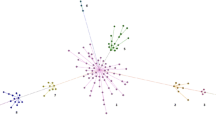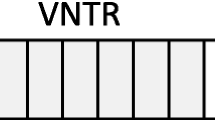Summary
A member of the young PV Alu sub-family is detected in chimpanzee DNA showing that the PV subfamily is not specific to human DNA. This particular Alu is absent from the orthologous loci in both human and gorilla DNAs, indicating that PV subfamily members transposed within the chimpanzee lineage following the divergence of chimpanzee from both gorilla and human. These findings and previous reports describing the transpositional activity of other Alu sequences within the human, gorilla, and chimpanzee lineages provide phylogenetic evidence for the existence of multiple Alu source genes. Sequences surrounding this particular Alu resemble known transcriptional control elements associated with RNA polymerase III, suggesting a mechanism by which cis-acting elements might be acquired upon retrotransposition.
Similar content being viewed by others
References
Batzer MA, Deininger PL (1991) A human-specific subfamily of Alu sequences. Genomics 9:481–487
Batzer MA, Kilroy GE, Richard PE, Shaikh TH, Desselle TD, Hoppens CL, Deininger PL (1990) Structure and variability of recently inserted Alu family members. Nucleic Acids Res 18:6793–6798
Botstein D, White RL, Skolnick M, Davis RW (1980) Construction of a genetic linkage map in man using restriction fragment length polymorphisms. Am J Hum Genet 32:314–331
Britten RJ, Kohne DE (1968) Repeated sequences in DNA. Science 161:529–540
Britten RJ, Baron WF, Stout DB, Davidson EH (1988) Sources and evolution of human Alu repeated sequences. Proc Natl Acad Sci USA 85:4770–4774
Cozzarelli NR, Gerrard SP, Schlissel M, Brown DD, Bogenhagen DF (1983) Purified RNA polymerase III accurately and efficiently terminates transcription of 5S RNA genes. Cell 34:829–835
Deininger PL, Slagel VK (1988) Recently amplified Alu members share a common parental Alu sequence. Mol Cell Biol 8:4566–4569
Economou-Pachnis A, Tsichlis PN (1985) Insertion of an Alu SINE in the human homologue of the Mlvi-2 locus. Nucleic Acids Res 13:8379–8387
Fan W, Kasahara M, Gutknecht J, Klein D, Mayer WE, Jonker M, Klein J (1989) Shared Class II MHC polymorphisms between humans and chimpanzees. Hum Immunol 26:107–121
Friezner Degen SJ, Rajput B, Reich E (1986) The human tissue plasminogen activator gene. J Biol Chem 261:6972–6985
Gibbs PE, Zielinski R, Boyd C, Dugaiczyk A (1987) Structure, polymorphism, and novel repeated DNA elements revealed by a complete sequence of the human alpha-fetoprotein gene. Biochemistry 26:1332–1343
Jagadeeswaran P, Forget BG, Weissman SM (1981) Short interspersed repetitive DNA elements in eucaryotes: transposable DNA elements generated by reverse transcription of RNA Pol III transcripts? Cell 26:141–142
Jurka J, Smith T (1988) A fundamental division in the Alu family of repeated sequences. Proc Natl Acad Sci USA 85:4775–4778
Labuda D, Striker G (1989) Sequence conservation in Alu evolution. Nucleic Acids Res 17:2477–2491
Lehrman MA, Goldstein JL, Russel D, Brown MS (1987) Duplication of seven exons in LDL receptor gene caused by Alu-Alu recombination in a subject with hypercholesterolemia. Cell 48:827–835
Lobo SM, Hernandez N (1989) A 76 by mutation converts a human RNA polymerase II snRNA promoter into an RNA polymerase III promoter. Cell 58:55–57
Maeda N, Bliska JB, Smithies O (1983) Recombination and balanced chromosome polymorphism suggested by DNA sequences 5′ to the human delta globin gene. Proc Natl Acad Sci USA 80:5012–5016
Maeda N, Wu C-I, Bliska J, Reneke J (1988) Molecular evolution of intergenic DNA in higher primates: pattern of DNA changes, molecular clock and evolution of repetitive sequences. Mol Biol Evol 5:1–20
Maraia R(1991) The subset of mouse B1 (Alu equivalent) sequences expressed as small processed cytoplasmic transcripts. Nucleic Acids Res 19:5695–5702
Margottin F, Dujardin G, Gerard M, Egly JM, Huet J, Sentenac A (1991) Participation of the TATA factor in transcription of the yeast U6 gene by RNA polymerase. Science 251:424–426
Matera AG, Hellmann U, Hintz MF, Schmid CW (1990a) Recently transposed Alu repeats result from multiple source genes. Nucleic Acids Res 18:6019–6023
Matera AG, Hellmann U, Schmid CW (1990b) A transpositionally and transcriptionally competent Alu subfamily. Mol Cell Biol 10:5424–5432
Mietus-Snyder M, Charmley P, Korf B, Ladias JAA, Gatti RA, Karathanasis SK (1990) Genetic linkage of the human apolipoprotein AI-CIII-AIV gene cluster and the neural cell adhesion molecule (NCAM) gene. Genomics 7:63–67
Muratani K, Hada T, Yamamoto Y, Kaneko T, Shigeto Y, Ohue T, Furuyama J, Higashino K (1991) Inactivation of the cholinesterase gene by Alu insertion: possible mechanism for human gene transposition. Proc Natl Acad Sci USA 88:11315–11319
Murphy S, Di Liegro C, Melli M (1987) The in vitro transcription of the 7SK RNA gene by RNA polymerase III is dependent only on the presence of an upstream promoter. Cell 51: 81–87
Platt T (1986) Transcription termination and the regulation of gene expression. Annu Rev Biochem 55:339–372
Quentin Y (1989) Successive waves of fixation of B1 variants in rodent lineage history. J Mol Evol 28:299–305
Ryan SC, Dugaiczyk A (1989) Newly arisen DNA repeats in primate phylogeny. Proc Natl Acad Sci USA 86:9360–9364
Schmid CW (1991) Human Alu subfamilies and their methylation revealed by blot hybridization. Nucleic Acids Res 19: 5613–5617
Schmid CW, Shen CKJ (1985) The evolution of interspersed repetitive DNA sequences in mammals and other vertebrates. In: MacIntyre RJ (ed) Molecular evolutionary genetics. Plenum, New York, pp 323–358
Schmid CW, Deka N, Matera AG (1990) Repetitive human DNA: the shape of things to come. In: Adolph KW (ed) Chromosomes: eukaryotic, prokaryotic and viral. CRC Press, Boca Raton FL, pp 3–29
Shen MR, Batzer MA, Deininger PL (1991) Evolution of the master Alu gene(s). J Mol Evol 33:311–320
Sibley CG, Alhquist JE (1990) DNA hybridization evidence of hominoid phylogeny: a reanalysis of the data. J Mol Evol 30: 202–236
Slagel V, Flemington E, Traina-Dorge V, Bradshaw H Jr, Deininger PL (1987) Clustering and sub-family relationships of the Alu family in the human genome. Mol Biol Evol 4:19–29
Stoppa-Lyonnet D, Carter PE, Meo T, Tose M (1990) Clusters of intragenic Alu repeats predispose the human C 1 inhibitor locus to deleterious rearrangements. Proc Natl Acad Sci USA 87:1551–1555
Trabuchet G, Chelbloume Y, Savatier P, Lachuer J, Faure C, Verdier G, Nigon VM (1987) Recent insertion of an Alu sequence in the beta-globin cluster of the gorilla. J Mol Evol 25:288–291
Ullu E, Weiner AM (1984) Human genes and pseudogenes for the 7SL RNA component of the signal recognition particle. EMBO J 3:3303
Ullu E, Weiner AM (1985) Upstream sequences modulate the internal promoter of the human 7SL RNA gene. Nature 318: 371–374
Van Arsdell SW, Denison RA, Bernstein LB, Weiner AM (1981) Direct repeats flank three small nuclear DNA pseudogenes in the human genome. Cell 26:11–17
Wallace MR, Andersen LB, Saulino AM, Gegory PE, Glover TW, Collins FS (1991) A de novo Alu insertion results in neurofibromatosis type 1. Nature 353:864–866
Weiner AM, Deininger PL, Efstratiadis AE (1986) Nonviral retroposons: genes, pseudogenes, and transposable elements generated by the reverse flow of genetic information. Annu Rev Biochem 55:631–662
Willard C, Nguyen HT, Schmid CW (1987) Existence ofat least three distinct Alu subfamilies. J Mol Biol 26:180–186
Author information
Authors and Affiliations
Additional information
Offprint requests to: C. W. Schmid
Rights and permissions
About this article
Cite this article
Leeflang, E.P., Liu, WM., Hashimoto, C. et al. Phylogenetic evidence for multiple Alu source genes. J Mol Evol 35, 7–16 (1992). https://doi.org/10.1007/BF00160256
Received:
Accepted:
Issue Date:
DOI: https://doi.org/10.1007/BF00160256




